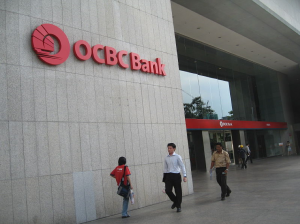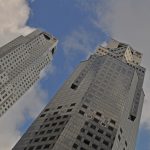OCBC Group second quarter earnings rose 5% from the first quarter to S$730 million
On Aug 7, the Oversea-Chinese Banking Corporation Limited (“OCBC Bank”) reported its financial results for the first half of 2020 (“1H20”). Group net profit for 1H20 was S$1.43 billion, 42% lower than a year ago, after prudently setting aside significantly higher allowances against expected credit losses on a forward-looking basis in the deteriorating economic environment brought about by the COVID-19 pandemic.
 OCBC Group net profit for the second quarter (“2Q20”) was S$730 million, up 5% from the previous quarter (“1Q20”) and 40% lower compared to a year ago (“2Q19”).
OCBC Group net profit for the second quarter (“2Q20”) was S$730 million, up 5% from the previous quarter (“1Q20”) and 40% lower compared to a year ago (“2Q19”).
OCBC Group First Half 2020 performance
| S$ million | 1H20 | 1H19 | YoY (%) |
| Banking Operations | |||
| Total income | 4,564 | 4,557 | – |
| Operating expenses | (2,088) | (2,090) | – |
| Associates | 336 | 326 | 3 |
| Operating profit before allowances | 2,812 | 2,793 | 1 |
| Allowances | (1,404) | (359) | 291 |
| Net profit – Banking operations | 1,160 | 2,028 | (43) |
| Net profit – Insurance operations | 268 | 426 | (37) |
| Net profit – Group | 1,428 | 2,454 | (42) |
Banking Operations Performance
- 1H20 operating profit before allowances was 1% higher from a year ago.
- Earnings in the first two months of 2020 were strong, but these were impacted from March onwards by increased business disruptions and slowdown in customer activities as countries implemented various measures to limit movements and interactions to curb virus transmissions. The half-year period also saw a severe contraction in the global economy, significant financial market volatility and aggressive policy support measures, including sizeable cuts in global interest rates and sharp increases in fiscal spending to drive growth and demand.Towards the end of the second quarter, there was some pick-up in activity in our key markets as economies cautiously reopened, while financial markets also gradually recovered from their March lows. Despite the early signs of a very gradual recovery, the weak business and consumer sentiments continued to weigh on capital investments, as well as employment, trade and economic growth.
- Total income for 1H20 of S$4.56 billion was unchanged YoY.
- Net interest income of S$3.05 billion was slightly below the S$3.07 billion a year ago, as a 5% YoY increase in assets was offset by a sharp decline in net interest margin (“NIM”) particularly in 2Q20. Against the previous year, the Group’s NIM fell 10 basis points to 1.68% in 1H20, due to the compression of asset yields in a low interest rate environment which more than offset the drop in funding costs. The effect of a lower loans-to-deposits ratio (“LDR”) from strong deposit growth was a contributing factor as well.
- Non-interest income rose 2% to S$1.51 billion from S$1.49 billion a year ago.Net trading income was 13% higher YoY, led by increased customer-driven treasury activities, while net gains from the sale of investment securities rose by S$65 million.Net fee income was 4% lower YoY, as transactional and credit card fees were impacted by reduced customer activity during the enforced movement restriction period. These more than offset a rise in fees from wealth management earned especially in early 1Q20 and brokerage from higher online trading activities.Assets under management at our private banking subsidiary Bank of Singapore grew 8% QoQ and 1% YoY to US$113 billion (S$157 billion) as at 30 June 2020.
- Operating expenses were well-managed and relatively unchanged YoY at S$2.09 billion.
- Total allowances were substantially higher at S$1.40 billion (see further analysis below).
Insurance Operations Performance
- Net profit contribution from insurance subsidiary Great Eastern Holdings (“GEH”) was 37% lower YoY at S$268 million as compared to S$426 million a year ago. This was largely attributable to unrealised mark-to-market losses in its investment portfolio arising from unfavourable market conditions, which more than offset a 57% rise in operating profit from its underlying insurance business.
- Total weighted new sales were 7% higher YoY at S$585 million, while new business embedded value (“NBEV”) was S$235 million, with the NBEV margin lower at 40.2% for 1H20 due to product mix.
Second Quarter 2020 Performance
| S$ million | 2Q20 | 1Q20 | QoQ (%) | 2Q19 | YoY (%) |
| Total income | 2,625 | 2,490 | 5 | 2,618 | – |
| Operating expenses | (1,107) | (1,109) | – | (1,151) | (4) |
| Associates | 163 | 165 | (2) | 146 | 11 |
| Operating profit before allowances | 1,681 | 1,546 | 9 | 1,613 | 4 |
| Allowances | (750) | (657) | 14 | (111) | 582 |
| Group net profit | 730 | 698 | 5 | 1,223 | (40) |
Quarter-on-quarter Performance
-
- The Group’s operating profit before allowances rose 9% from higher total income and flat expense growth.
- Total income rose 5% YoY to S$2.63 billion.
- Net interest income fell 9% to S$1.48 billion, largely from a 16 basis points decline in NIM as asset pricing adjusted to the significant cuts in interest rates faster than the reduction in customer deposit funding costs.
- Non-interest income rose 32% to S$1.14 billion, as improved financial market conditions drove trading income and insurance profit higher QoQ. However, net fee income was 19% lower, attributable to a slowdown in customer activity and reduced branch traffic as tighter social distancing measures were implemented during the quarter.
- Operating expenses were unchanged QoQ at S$1.11 billion, with the cost-to-income ratio lower at 42.2% as compared to 44.5% in 1Q20.
-
- Allowances of S$750 million were higher as compared to S$657 million in the previous quarter.
Year-on-year Performance
- Against the previous year, operating profit before allowances grew 4%, driven by increased associates’ contributions and a reduction in operating expenses.
- Net interest income fell 7% as asset growth was more than offset by margin compression.
- Non-interest income rose 11% mainly attributable to increased trading and insurance income.
- Operating expenses fell 4% YoY, while allowances were significantly higher from a year ago
Asset Quality and Allowances
| S$ million | Jun 2020 | Jun 2019 | Mar 2020 | ||
| Non-performing assets (NPAs) | 4,351 | 3,914 | 4,386 | ||
| Non-performing loan (NPL) ratio | 1.6% | 1.5% | 1.5% | ||
| Coverage – total NPAs | 101% | 78% | 90% | ||
| Coverage – unsecured NPAs | 284% | 252% | 234% | ||
| Credit costs (bps) | 1H20 | 1H19 | |||
| Impaired loans | 51 | 22 | |||
| Total loans | 91 | 25 | |||
As at 30 June 2020, total NPAs were S$4.35 billion, 1% below the S$4.39 billion a quarter ago from higher recoveries, upgrades and write-offs. Compared to the S$3.91 billion a year ago, total NPAs were 11% higher, mainly attributable to downgrades of accounts in the transportation, manufacturing and general commerce sectors. New NPA formation in 2Q20 was S$496 million, lower than the S$623 million in the first quarter. As at 30 June 2020, the NPL ratio was 1.6%.
As at 30 June 2020, allowance coverage against total NPAs of 101% was well above the 78% a year ago. Coverage against unsecured NPAs of 284% was also higher as compared to 252% in the previous year.
The OCBC Group significantly raised its allowances in 1H20, with total allowances charged to the income statement of S$1.41 billion substantially higher than the S$360 million a year ago. The S$1.05 billion YoY increase in allowances comprised:
- a S$579 million increase in allowances for non-impaired assets (ECL stage 1 and 2) to S$614 million. This included S$197 million in macro-economic variable (“MEV”) adjustments, and S$300 million in management overlays above the ECL model requirements, reflecting prudent steps taken to buffer the portfolio on a forward-looking basis, in view of the very uncertain market and economic outlook.
- a S$468 million rise in allowances for impaired assets to S$793 million. Allowances in 1H20 largely comprised allowances made for a Singapore-based corporate customer in the oil trading sector first recognised in the first quarter, and additional allowances made in the second quarter to conservatively write down the carrying value of the existing offshore support vessels (“OSV”) NPLs in view of the poor outlook for the sector. The decline in OSV employment was further aggravated by significantly reduced oil demand as a result of the prolonged COVID-19 pandemic.
Strong Funding, Liquidity and Capital Position
| Jun 2020 | Jun 2019 | Mar 2020 | |
| CASA ratio | 56.7% | 47.9% | 51.0% |
| All-ccy LCR | 139% | 151% | 151% |
| CET1 CAR | 14.2% | 14.4% | 14.3% |
| Leverage ratio | 7.4% | 7.5% | 7.4% |
OCBC Group Customer loans rose 2% YoY to S$268 billion as at 30 June 2020, but were 1% lower QoQ from a fall in consumer and trade-related credit demand as economic activity slowed in the second quarter. Customer deposits grew 4% to S$310 billion and comprised 79% of the Group’s funding base. The loans-to-deposits ratio was 85.4%, lower than the 87.6% a year ago. Current account and savings deposits (“CASA”) increased 24% to a record S$175 billion as at 30 June 2020, while the CASA ratio rose to a new high of 56.7%.
For 1H20, the average all-currency liquidity coverage ratio for the OCBC Group was 139%, while the net stable funding ratio was 119%.
Common Equity for OCBC Group Tier 1 capital adequacy ratio was 14.2%, slightly below the 14.3% as at 31 March 2020. The leverage ratio was 7.4%, unchanged from the previous quarter.
These regulatory ratios were all above their respective regulatory requirements.
Dividend
| Cents Per Share | 2020 | 2019 | |
| Interim dividend | 15.9 | 25.0 | |
| Final dividend | 28.0 |
Given the uncertain economic climate, the MAS has called on all locally-incorporated banks headquartered in Singapore to cap the total dividend per share for FY20 at 60% of that of the prior year, and to offer shareholders the scrip dividend option. Under the guideline, the maximum dividend per share that OCBC can declare would be 31.8 cents for FY20 or 60% of FY19’s 53 cents.
For the first half of 2020, an interim dividend of 15.9 cents per share has been declared. This represents half of the maximum 31.8 cents dividend per share that could be paid out in FY20. The estimated interim dividend payout will amount to S$700 million, representing 49% of the 1H2020 net profit for OCBC Group.
The Scrip Dividend Scheme will be applicable to the interim dividend, giving shareholders the option to receive the dividend in the form of shares, with the issue price of the shares set at a 10% discount.
OCBC Group continues to be firmly committed to delivering long-term sustainable returns to shareholders, while ensuring that its customers, employees and the community are fully supported through this unprecedented crisis.
Message from OCBC Group CEO, Samuel Tsien
“With the ongoing pandemic and rising geo-political risks, the near-term market outlook is very uncertain. Despite the unprecedented size of government and central bank relief programmes extended across the world, business and consumer sentiments continued to be weak. The emergence of economies towards the road to recovery will be slow and challenging. During this time, we are committed to continuing our support to customers, employees and the community as we navigate this crisis together.
It is important for banks to defensively shore up their balance sheet and prepare for the slow recovery. This is exactly what we have done since the start of the pandemic crisis. We protected our customer franchise, managed our expenses in line with income expectations, increased our allowance coverage, preserved our capital and raised our capital efficiency to position for the future post-pandemic. We will continue to contain all discretionary expenditure, including management compensation.
Our first half performance reflects the underlying strength of OCBC’s diversified business model and franchise. Despite the very challenging macro-economic environment, our banking franchise achieved a year-on-year improvement in operating profit before allowances, while our insurance business delivered a rise in operating profit and weighted new sales. OCBC’s capital, liquidity and funding position remained strong and we are committed to delivering sustainable returns to shareholders.
Despite the turmoil since the start of the COVID-19 pandemic, we have stayed focused on our corporate strategy to drive long-term sustainable value. We must also look beyond this pandemic to capture opportunities presented by prevailing economic trends to emerge stronger and relevant in a post-pandemic world.
I am deeply grateful to OCBC’s employees – working from home or safely returning to the workplace – who continue to champion our core values by demonstrating steadfast dedication in serving our customers and the community through this unprecedented period. We are equally appreciative of the support of our customers during these challenging times.”






